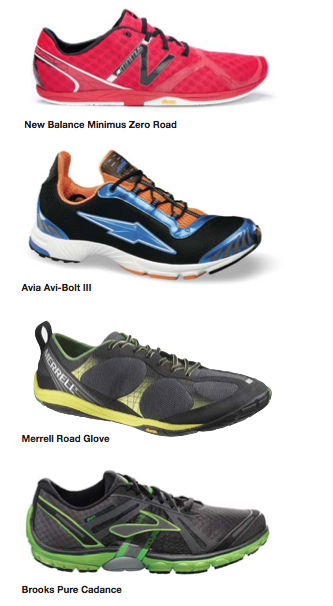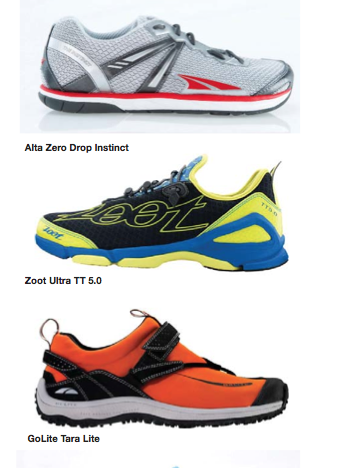 The just-held summer Outdoor Retailer (OR) Show, which takes place each year in Salt Lake City, can easily overwhelm the senses and send a gear nerd or wilderness aficionado into paroxysms of utter bliss. All the established companies like North Face, Salomon, Mountain Hardwear, and Columbia have huge booths, whereas newcomers in small stalls are hoping to land the next big thing. Change occurs fast in the outdoor retail sector. We are seeing that happen with running and walking footwear. A feature article on minimalist running shoes at the OR show appears in the current issue of the sporting goods industry trade journal SGB Weekly: “Along with a few traditional brands such as Brooks, New Balance and Saucony, trail running brands like Salomon, GoLite and Vasque, and lifestyle brands K-Swiss and Skechers, were all touting solutions to the less-is-more craze.
The just-held summer Outdoor Retailer (OR) Show, which takes place each year in Salt Lake City, can easily overwhelm the senses and send a gear nerd or wilderness aficionado into paroxysms of utter bliss. All the established companies like North Face, Salomon, Mountain Hardwear, and Columbia have huge booths, whereas newcomers in small stalls are hoping to land the next big thing. Change occurs fast in the outdoor retail sector. We are seeing that happen with running and walking footwear. A feature article on minimalist running shoes at the OR show appears in the current issue of the sporting goods industry trade journal SGB Weekly: “Along with a few traditional brands such as Brooks, New Balance and Saucony, trail running brands like Salomon, GoLite and Vasque, and lifestyle brands K-Swiss and Skechers, were all touting solutions to the less-is-more craze.
“Zoot, marking its first OR appearance since 2008, previewed its fast-looking Ultra TT 5.0 while Avia showcased its 7.4 oz Avi-Bolt III. Ecco launched its first BIOM trail shoe and a new BIOM Lite trainer that encourages foot and lower leg strengthening. Oversized approaches to the natural running movement came from Hoka One One and Tecnica. Newer brands addressing the minimal opportunity exhibiting at the show included Terra Plana, Inov-8 and Altra Zero Drop Footwear, which was recently acquired by fitness equipment giant Icon Health & Fitness.
“Merrell again saw a busy booth as it widely expanded its barefoot collection to cover road running, transitional shoes, water shoes, training and a Barefoot Life collection encompassing a slip-on moc, ballet slipper, Mary Jane and flip flop. New Balance introduced the first zero-drop version of the NB Minimus collection. Vibram, which partnered with both brands on their minimal approaches, also introduced new running and casual styles on its own.”
The primary thrust of the article was an inquiry into minimalism either as a flash-in-the-pan trend or real movement with staying power and legs. A number of footwear company execs and one founder (Kigo) were quoted in the piece. Here’s a selection of excerpts. Opinions naturally varied across the shoe spectrum.
 “It’s a great category to be in,” said Dave Jewell, footwear category manager at Zoot Sports. “What it looks like is more running shoes will start to get closer in minimalist construction to the minimalist shoes. Maybe running shoes {will} meld with minimalism and they simply become the evolution of running shoes.”
“It’s a great category to be in,” said Dave Jewell, footwear category manager at Zoot Sports. “What it looks like is more running shoes will start to get closer in minimalist construction to the minimalist shoes. Maybe running shoes {will} meld with minimalism and they simply become the evolution of running shoes.”
“I think there is the concern in the industry,” said Scott Briggs, president of GoLite Footwear. “Just like the whole wellness category that spiked so quickly and then imploded, I think people are looking over their shoulders and saying, ‘Is this growing too fast?’ ‘Are too many people coming in here?’ “It’s woken up the industry to the benefits of what we’re really doing and providing. I also think it’s been great for the consumer. It’s making them challenge everything they’re doing and buying and it’s given a boost to the category. It’s one of the reasons it’s so healthy.”
“Fran Allen, VP of global sales at Saucony, also does not see a ‘boom and bust’ cycle with minimal akin to toning. ‘First, the growth has been more gradual. Secondly, this was a grassroots movement, created and fueled by consumers, in stark contrast to the heavily-promoted, overly-hyped toning category created by marketers. We are now looking at different ways to construct running shoes, building a more neutral/natural foot position…Kinvara Peregrine Trail shoes, and the Nike Free – could become bigger than the zero-drop, very minimal shoes because it more easily reaches a wider group of runners. Our Kinvara could end up being our number one shoe in the near future. Why? Because it is not as radical a departure from ‘traditiona]” running shoes, it doesn’t require a slow build up in how much you can use it.”
“Bryan Gothie, senior product manager for New Balance Outdoor, agreed that the lightweight and minimal trend does continue to strengthen and evolve a little differently for brands. ‘In addition to concepts that push the envelope such as our new NB Minimus Zero collection, which launches for spring 2012, we are looking more closely at our products across all categories to identify methods to reduce weight or create a more minimal experience. We are lowering the heel-to-toe drop in some of our performance running shoes to encourage a more natural running motion.Motion control shoes that have traditionally been a bigger, beefier shoe, can still be improved with new materials and constructions that create a more lightweight experience without sacrificing performance – not necessarily lightweight, but lighter.”
“Jared Aldrich, running specialty national sales manager at Merrell, sees minimalism as more of a ‘movement’ than a trend.’Barefoot will be a core part of our Merrell business and is staged to grow more as we bring the benefits of barefoot beyond running and into other outdoor activities like water, train and life. We are going to show a commitment to the run specialty channel with a dedicated sales team.But he recognized that the rising number of brands entering the minimal category will be a challenge for retailers deciding on what minimal styles make the cut.We believe Merrell has a spot on the selling wall based upon our core beliefs and our early adoption into the barefoot category. Our core beliefs would consist of education being a top priority, true barefoot shoes equaling zero drop, and a focus in creating the transitional or minimalist shoes. We will continue to develop our educational assets so our customers and the consumer have what they need for a fun and healthy barefoot experience. This side effect will also justify a line of ‘transitional shoes’ that we will launch in Spring of 2012.”
“Rachelle Kuramoto, co-founder and director of marketing for Kigo Footwear, an eco-friendly minimalist footwear line that marked its second OR show, agreed that while minimalist shoes have proven they can reduce injury, it’s not ‘a panacea for injury or magic performance enhancer. I think we will see more serious training and education programs, as well as more lifestyle offerings that allow people to walk, play, work, etc. in their minimalist shoes in order to strengthen and prepare their bodies to benefit from natural motion.”
